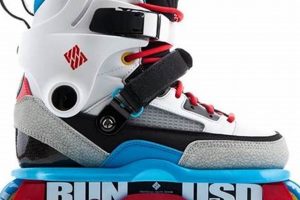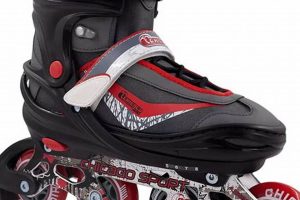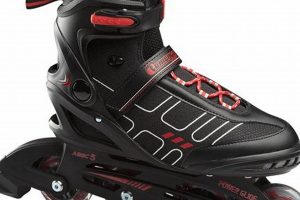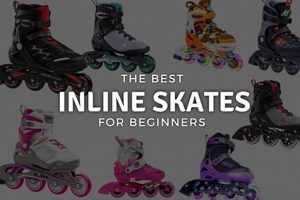These devices are a type of roller skate featuring a configuration where wheels are arranged in a single line. This contrasts with traditional quad skates, which have two wheels in the front and two in the back. The in-line design allows for greater speed and maneuverability, making them suitable for various activities, including recreational skating, fitness training, and competitive sports.
The benefits of using this type of skate include improved cardiovascular health, enhanced lower body strength, and the development of balance and coordination. Their historical development involved numerous iterations, evolving from early attempts to simulate ice skating on pavement to the sophisticated models available today. This evolution has broadened their appeal across different age groups and skill levels.
The following discussion will delve into the different types of these skates, the key components that make them function, essential safety considerations, and tips for maintenance and care to ensure a safe and enjoyable experience. This exploration aims to provide a comprehensive understanding for both beginners and experienced users.
Essential Guidance for Safe and Effective Use
The following provides crucial advice for optimizing performance and ensuring safety when using these devices. Adhering to these guidelines will contribute to a more fulfilling and secure experience.
Tip 1: Prioritize Protective Gear: Helmets, wrist guards, elbow pads, and knee pads are essential safety equipment. Consistent use of these items significantly reduces the risk of injury in the event of a fall or collision.
Tip 2: Master Basic Skills: Before attempting advanced maneuvers, proficiently executing fundamental techniques such as balancing, gliding, stopping, and turning is crucial. A solid foundation minimizes the likelihood of accidents.
Tip 3: Select Appropriate Skating Environments: Opt for smooth, paved surfaces free from obstacles like potholes, gravel, or heavy pedestrian traffic. Controlled environments are safer, particularly for novice users.
Tip 4: Maintain Equipment Regularly: Inspect wheels, bearings, and braking systems before each use. Properly maintained equipment performs optimally and reduces the risk of mechanical failure.
Tip 5: Control Speed and Awareness: Maintain a manageable speed that allows for quick reactions to unexpected situations. Continuously scan the surrounding environment for potential hazards, including other skaters, pedestrians, and vehicles.
Tip 6: Learn Proper Braking Techniques: Familiarize with various braking methods appropriate for different speeds and situations. Effective braking is vital for avoiding collisions and maintaining control.
Tip 7: Stay Hydrated and Take Breaks: Engage in regular hydration, especially during prolonged skating sessions. Taking periodic breaks helps prevent fatigue and maintains focus.
Implementing these recommendations enhances user safety, promotes responsible usage, and maximizes the benefits of participating in this activity.
The article will now progress to detailed information about different models, components, and upkeep strategies.
1. Configuration
The in-line configuration is a defining characteristic. Unlike traditional quad skates, these devices position wheels in a single line along the skate’s frame. This design fundamentally alters the skate’s performance characteristics, impacting speed, agility, and stability. The specific arrangement influences how force is distributed across the wheels, affecting the skater’s ability to generate momentum and execute turns. As an example, a longer wheelbase (distance between the first and last wheel) generally provides greater stability at higher speeds, while a shorter wheelbase enhances maneuverability for more technical skating styles.
The in-line wheel arrangement impacts the potential applications. Skates with larger wheels, optimized for speed, are frequently used in marathon skating and speed skating. Conversely, skates with smaller, more closely spaced wheels find applications in aggressive skating and freestyle disciplines where rapid turns and intricate movements are paramount. The configuration also affects the type of boot and frame that can be used, further tailoring the skate to specific activities. A hockey skate, for instance, will have a more rigid boot and a shorter frame for agility and responsiveness, compared to a recreational skate designed for comfort and stability.
In summary, the configuration is integral to understanding their functionality. The arrangement of the wheels directly influences the skate’s performance attributes, its suitability for various activities, and the overall user experience. A deeper comprehension of this aspect enables informed decisions when selecting a model, optimizing skating technique, and ensuring safe participation. The configuration, therefore, is not merely an attribute but a foundational element that defines the characteristics of these skates.
2. Maneuverability
The inherent design of these skates directly impacts their maneuverability, a critical attribute for various skating disciplines. The in-line wheel arrangement fundamentally alters the way skaters can navigate and control their movements, influencing their ability to perform turns, stops, and intricate maneuvers.
- Wheelbase Length
The wheelbase, or the distance between the first and last wheel, is a primary determinant of maneuverability. A shorter wheelbase generally enhances agility, allowing for quicker turns and sharper movements. This is particularly beneficial in disciplines like aggressive skating and hockey, where rapid directional changes are crucial. Conversely, a longer wheelbase provides greater stability at higher speeds but reduces the skate’s responsiveness in tight spaces. The wheelbase length is a trade-off between stability and agility, influencing the skater’s control and precision.
- Wheel Diameter and Profile
The diameter and profile of the wheels also significantly affect maneuverability. Smaller wheels tend to be more agile and responsive, making them suitable for technical skating styles that require quick acceleration and tight turns. Larger wheels, while providing greater speed and roll efficiency, can be less responsive in tight turns. The wheel profile, whether rounded or flat, influences the contact area with the skating surface, which impacts grip and turning ability. A rounded profile allows for smoother transitions during turns, while a flatter profile provides more grip for straight-line speed.
- Frame Material and Flexibility
The material and flexibility of the skate’s frame contribute to its overall maneuverability. Frames made from stiffer materials, such as aluminum, offer greater responsiveness and energy transfer, allowing skaters to execute turns with greater precision. More flexible frames, often found in recreational skates, provide a more forgiving ride but may sacrifice some responsiveness. The frame’s design, including its length and shape, also influences the skate’s turning radius and stability. A well-designed frame optimizes energy transfer and control, enhancing the skater’s ability to maneuver effectively.
- Boot Stiffness and Ankle Support
The stiffness of the boot and the level of ankle support are essential for maneuverability. A stiffer boot provides more direct control over the skate, allowing for quicker and more precise movements. Adequate ankle support is crucial for maintaining balance and stability during turns and maneuvers. Skates with higher cuffs and stiffer boots are often preferred for activities that require greater control and support, such as aggressive skating and speed skating. Recreational skates may have softer boots and less ankle support to enhance comfort and flexibility.
In summary, maneuverability in these skates is a multifaceted characteristic influenced by several design elements. The interplay between wheelbase length, wheel diameter and profile, frame material and flexibility, and boot stiffness and ankle support determines the skate’s responsiveness and agility. A deeper understanding of these factors enables skaters to select skates that align with their specific needs and skating styles, maximizing their ability to navigate and control their movements effectively. The maneuverability, therefore, is not merely an aspect of its usage but a characteristic defined by the combination of its design.
3. Applications
The utility of these skates extends across a diverse range of activities, showcasing their adaptability and relevance in both recreational and professional contexts. The specific design features of a given model often dictate its suitability for particular applications.
- Recreational Skating
This constitutes a primary application, encompassing casual use for leisure, fitness, and transportation. Recreational models prioritize comfort and stability, often featuring softer boots and longer wheelbases. This application emphasizes ease of use and accessibility for a broad range of users.
- Fitness Training
The utilization of these skates for cardiovascular exercise and lower body conditioning represents a significant application. Fitness-oriented models are designed to optimize energy transfer and efficiency, facilitating longer workouts and improved performance. This application focuses on health and wellness benefits.
- Aggressive Skating
This application involves performing tricks and stunts in skate parks and urban environments. Aggressive models prioritize durability and maneuverability, featuring reinforced boots, smaller wheels, and robust frames. This application emphasizes skill and technical proficiency.
- Speed Skating
This competitive application focuses on achieving maximum velocity on designated courses. Speed models prioritize aerodynamic efficiency and power transfer, featuring lightweight boots, long wheelbases, and large diameter wheels. This application emphasizes athletic performance and competition.
The diverse applications underscore the adaptability of these skates. While recreational use provides a broad entry point, specialized models cater to the specific demands of fitness training, aggressive skating, and speed skating. This versatility contributes to their continued relevance across different user groups and activity types.
4. Components
The functionality and performance of these skates hinge directly on the interplay of several key components. Understanding these components is essential for proper maintenance, safe operation, and informed selection based on intended use.
- Boot
The boot provides support, protection, and control. Constructed from various materials, including hard plastics, composite materials, and padded liners, its stiffness and design influence stability and responsiveness. The boot’s closure system, often involving laces, buckles, or straps, secures the foot and ankle. Different skating styles necessitate variations in boot design, with aggressive skates featuring reinforced boots for impact resistance and speed skates employing lightweight, low-cut boots for enhanced ankle mobility.
- Frame
The frame connects the boot to the wheels and bearings, dictating the skate’s wheelbase and influencing maneuverability. Frames are typically made from aluminum, composite materials, or plastic, with aluminum offering greater stiffness and energy transfer. Frame length and wheel configuration (number and size of wheels) affect stability and turning radius. Aggressive skates utilize shorter, more durable frames, while speed skates employ longer frames to accommodate larger wheels.
- Wheels
Wheels provide the rolling contact with the skating surface. They are characterized by diameter and durometer (hardness). Larger diameter wheels offer increased speed and roll efficiency but may reduce maneuverability. Softer wheels (lower durometer) provide greater grip and shock absorption but wear more quickly. Harder wheels (higher durometer) offer greater speed and durability but may be less comfortable on rough surfaces. Wheel selection depends on the intended skating surface and style, with aggressive skaters often using smaller, harder wheels and speed skaters using larger, harder wheels.
- Bearings
Bearings facilitate smooth wheel rotation. Encased within the wheel hub, they reduce friction between the wheel and the axle. Bearings are typically rated using the ABEC (Annular Bearing Engineering Committee) scale, with higher ratings indicating greater precision and efficiency. However, factors such as lubrication and maintenance also significantly impact bearing performance. Clean, well-lubricated bearings contribute to faster speeds and smoother rides.
These core components boot, frame, wheels, and bearings work in concert to enable the functionality of inline skates. Their materials, design, and configuration directly affect the skater’s experience, influencing performance, comfort, and safety. Proper maintenance and informed component selection are essential for maximizing the lifespan and utility of these devices.
5. Maintenance
The operational lifespan and safety of inline skates are inextricably linked to consistent and thorough maintenance practices. Neglecting upkeep can lead to diminished performance, increased risk of injury, and premature equipment failure. Component degradation, such as worn bearings or damaged wheels, directly impacts the skate’s maneuverability and stability. A real-world example includes bearing failure, resulting in reduced wheel spin and potential instability at higher speeds, thereby increasing the risk of falls. Similarly, damaged frames compromise structural integrity, affecting control and potentially leading to catastrophic failure under stress.
Regular maintenance extends beyond simple cleaning. It encompasses systematic inspection, lubrication, and component replacement. For example, bearings should be cleaned and lubricated periodically to maintain optimal rolling efficiency. Wheels should be rotated to ensure even wear and replaced when significantly worn or damaged. Frames and boots require regular inspection for cracks or damage, with prompt repairs undertaken to prevent further deterioration. The braking system, often a critical safety feature, demands frequent assessment and replacement of worn brake pads to ensure reliable stopping power. The failure to maintain brakes can lead to inability to stop at the point the user want, and can risk his life.
In conclusion, the connection between maintenance and inline skates transcends mere aesthetic considerations. Consistent, diligent upkeep is fundamental to ensuring optimal performance, maximizing safety, and extending the equipment’s operational life. By adhering to a proactive maintenance schedule, users mitigate the risks associated with component failure and maintain the functionality and integrity of their inline skates. The maintenance requirements are thus integral to the overall experience and should be considered a crucial aspect of responsible ownership.
6. Safety
Safety is of paramount importance in the context of these skates. The inherent nature of the activity, involving dynamic movement and varying speeds, necessitates adherence to safety protocols and the utilization of appropriate protective measures. A comprehensive understanding of safety considerations is crucial for mitigating risks and ensuring a positive experience.
- Protective Gear Utilization
The consistent use of protective gear, including helmets, wrist guards, elbow pads, and knee pads, is a fundamental safety measure. Helmets mitigate the risk of head injuries, while wrist guards protect against fractures and sprains. Elbow and knee pads safeguard against abrasions and more severe joint trauma. Real-world data demonstrates a significant reduction in injury severity when protective gear is employed, highlighting its critical role in risk management.
- Skill Level and Environmental Awareness
A skater’s skill level directly correlates with their ability to safely navigate various environments. Novice skaters should begin in controlled settings, gradually progressing to more challenging environments as their skills improve. Environmental awareness, encompassing the identification and avoidance of hazards such as potholes, pedestrians, and traffic, is essential for preventing accidents. Ignoring environmental factors can result in collisions or falls, with potentially severe consequences.
- Equipment Maintenance and Inspection
Regular equipment maintenance and inspection are crucial for identifying and addressing potential safety hazards. Worn bearings, damaged wheels, and loose frames can compromise stability and control. Prior to each use, skaters should inspect their equipment for signs of wear or damage, addressing any issues promptly. Neglecting maintenance can lead to component failure, increasing the risk of accidents.
- Adherence to Traffic Regulations and Etiquette
When skating in public spaces, adherence to traffic regulations and basic etiquette is essential for ensuring safety. Skaters should obey traffic signals, yield to pedestrians, and maintain a safe distance from other users. Disregarding traffic regulations and exhibiting inconsiderate behavior can lead to collisions and conflicts, undermining the safety of both skaters and other individuals in the vicinity.
These safety facets, encompassing protective gear, skill level, equipment maintenance, and adherence to regulations, are inextricably linked to the responsible use of these skates. A comprehensive approach to safety minimizes the risk of injuries and promotes a positive and sustainable engagement with the activity. Neglecting these considerations not only endangers the individual skater but also compromises the safety and well-being of others.
Frequently Asked Questions About Inline Skates
The following addresses common inquiries concerning the nature, usage, and maintenance of inline skates, offering clarity and insight into their various aspects.
Question 1: What distinguishes inline skates from traditional quad skates?
The primary distinction lies in the wheel configuration. Inline skates feature wheels arranged in a single line along the frame, while quad skates have two wheels in the front and two in the back. This difference affects maneuverability, speed, and stability, influencing the suitability of each type for specific activities.
Question 2: Are these skates suitable for beginners?
While inline skates can be used by beginners, a gradual learning curve is typically involved. Prioritizing basic skills, such as balancing, gliding, and stopping, is crucial for ensuring safe and enjoyable initial experiences. Starting in controlled environments and utilizing appropriate protective gear is strongly recommended.
Question 3: What type of maintenance do inline skates require?
Maintenance includes regular cleaning, lubrication, and inspection of components. Bearings should be cleaned and lubricated, wheels should be rotated and replaced as needed, and frames and boots should be inspected for damage. Brake pads should also be checked and replaced to ensure proper stopping power.
Question 4: How does wheel durometer affect performance?
Wheel durometer, a measure of hardness, affects grip, speed, and durability. Softer wheels (lower durometer) provide greater grip and shock absorption but wear more quickly. Harder wheels (higher durometer) offer greater speed and durability but may be less comfortable on rough surfaces. The ideal durometer depends on the intended skating surface and style.
Question 5: What safety equipment is essential when using inline skates?
Essential safety equipment includes a helmet, wrist guards, elbow pads, and knee pads. These items provide crucial protection against head injuries, fractures, sprains, and abrasions. Consistent use of protective gear significantly reduces the risk of injury.
Question 6: Can inline skates be used for fitness training?
Yes, inline skates are effective for cardiovascular exercise and lower body conditioning. Fitness-oriented models are designed to optimize energy transfer and efficiency, facilitating longer workouts and improved performance. Skating engages multiple muscle groups and provides a challenging and enjoyable form of exercise.
In summary, a clear understanding of the key characteristics, maintenance requirements, and safety precautions is essential for a positive and responsible experience. The use of safety equipment and responsible skating is encourage at all times.
The following section provides a concise conclusion of the discussion.
Conclusion
This examination of what are inline skates has elucidated their defining characteristics, diverse applications, essential components, maintenance requirements, and crucial safety considerations. The single-line wheel configuration distinguishes them from traditional quad skates, influencing maneuverability and speed. The suitability for various activities, ranging from recreational skating to competitive speed skating, underscores their versatility. Maintenance, encompassing regular cleaning, inspection, and component replacement, is critical for ensuring both performance and longevity. Furthermore, the consistent use of appropriate protective gear and adherence to safety protocols are paramount for mitigating risks and promoting responsible usage.
Understanding the complexities associated with these skates enables informed decision-making and fosters a commitment to safe and responsible practices. Continued awareness of technological advancements and safety guidelines will further enhance the user experience and contribute to the ongoing evolution of this dynamic activity. The adoption of these guidelines promotes both personal well-being and the shared enjoyment of public spaces.



![Best Chicago Skates Inline Skates: [Year] Guide & More! Safem Fabrication - Precision Engineering & Custom Manufacturing Solutions Best Chicago Skates Inline Skates: [Year] Guide & More! | Safem Fabrication - Precision Engineering & Custom Manufacturing Solutions](https://cruzskateshop.com/wp-content/uploads/2025/06/th-3478-300x200.jpg)



